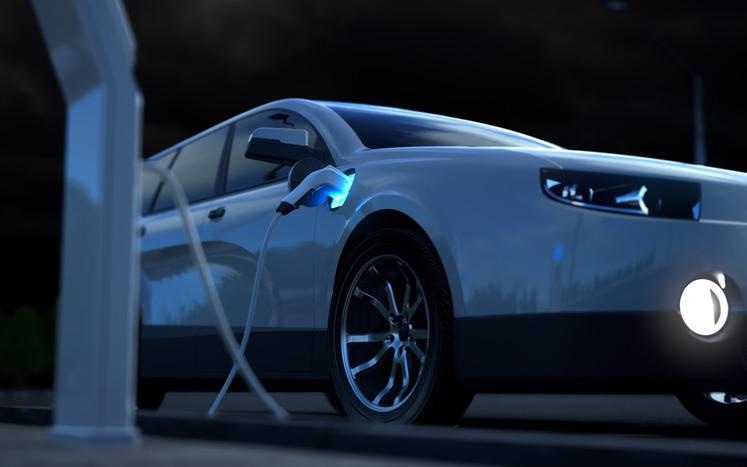Many different needs are met by electric vehicles. Electric vehicles are, before anything else, a mode of transportation, a green-friendly way to get from point A to point B. They arere a win for the environment as they boast no emissions. They are also a significant step toward eliminating a global fleet dependent on fossil fuels.

Image Credit: Amphenol Sensors
EVs bring a bonus selling point that their predecessors with an internal combustion engine (ICE) didn’t have: a major portable power supply. This does not just mean using an EV as a source to charge a cellphone.
Electric vehicles take energy stored within their batteries wherever they go thanks to advances in battery technology and storage capacity.
The stored energy is enough to power a house for a few days and can be used as a type of mobile power generation unit, capable of bringing electricity along without the noise and complication of gasoline generators.
Electric car battery packs use sophisticated sensor control and energy management systems as a mobile power bank to draw power from the local power grid. They are also able to push energy back to the grid, as well as being able to provide A/C plug power directly from its battery and inverter.
Electric vehicles open new doors to remote and emergency power supply that’s long-lasting, safe and efficient when paired with the appropriate sensor technology.
Four Applications Where Energy from EV Battery Packs Make a Difference
EV batteries provide clean and quiet electricity at a moment’s notice wherever they are, and, in many cases, without requiring special tools or training, something that combustion engine vehicle engines cannot do.
EV batteries bring electricity to places where a functional power source is absent, much like a generator. EV battery packs can act in many applications, including:
- Power outages: A fully charged EV in an average-sized (e.g., sedan) vehicle has 60-100 kilowatt-hours of power within its battery. This amount of stored energy equates to 1-3 days of energy for the average household during a power outage.
- Emergency operations: An EV provides precious power to emergency responders, from rescue operations in remote areas to sites of major catastrophes.
- Construction: EV cars and trucks provide another means to charge or run tools, and larger electric utility vehicles include a power bank to supply heavy equipment with energy. This means not having to worry about power tools running out of power.
- Leisure: EV battery power in a large camper can support RV “boondocking” without the noise and smell of portable generators. This means that getting off the grid doesn’t have to mean going dark.
Optimizing EV Power Transfer with Sensor Technology
An EV needs to be monitored when providing power, just as it does when receiving power.
No matter the direction of energy flow within an EV battery pack, the number one issue is responsive thermal management. Electric vehicle sensors enable maintaining peak battery performance when an EV serves as a power source, providing information on current in the system, voltage and critical temperatures.
EV transformers, inverters and batteries operate optimally within a temperature range of 15-45 °C. The battery can lose efficiency when outside of that range.
Overheating is the primary concern with electric vehicle battery thermal management, no matter if the battery is providing power or receiving it. EV batteries and inverters give off heat when providing power the same as they do when charging and powering the vehicle, especially when converting electricity from one form to another, such as A/C to D/C.
Internal degradation can occur if temperatures in the cell increase beyond 70 °C; this releases flammable gases and can potentially start thermal runaway. Once it starts, thermal runaway spreads, and can be extremely difficult to stop.
Sensor technology actively keeps battery pack thermal management systems engaged during the entirety of the power transfer.
Sensors monitor other elements of the pack’s cooling system for performance and can alert users to electrolyte or coolant leaks, water intrusion or other malfunctions in their early stages that might go unnoticed otherwise.
Enhanced real-time monitoring of thermal management systems is enabled by more advanced sensors, even going so far as to send text messages to the vehicle owner if something starts to go wrong.
However, preventing temperature spikes is only part of thermal management for EV batteries used as a mobile power source. EV batteries need to be brought up to at least 15 ? to function appropriately in colder environments.
Electric vehicle sensors can activate internal heating elements to bring systems up to the minimum temperature for operation, just like turning on an EV battery pack’s cooling systems.
EV Energy: Versatility in Motion
Electric vehicles represent the marriage of transportation and technology and are breaking new ground in mobility, bringing with them features that were previously impossible with ICE vehicles.
EVs take versatility to a new level and are more than just a means of moving things and people between destinations. The additional functionality of an EV and its battery packs, such as providing a mobile power solution, is safe and dependable with sensor technology.

This information has been sourced, reviewed and adapted from materials provided by Amphenol Sensors.
For more information on this source, please visit Amphenol Sensors.